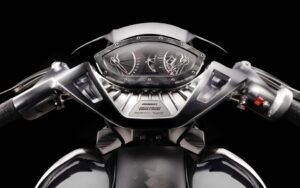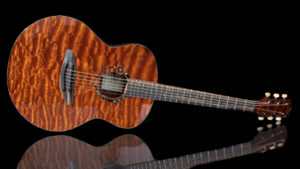It’s a curious phenomenon when masters of microscopic mechanical art decide to scale up. In the world of haute horology, Richard Mille reigns as one of the most disruptive and obsessive brands, known for watches that fuse extreme engineering with futuristic aesthetics. When this relentless pursuit of unique shifts from the wrist to the road, we get the RMB01, an audacious superbike born from a union with British motorcycle legend Brough Superior.
The RMB01 is not just a motorcycle. It is a sculptural object, a performance machine, and a rolling manifesto of analog passion in a digital age. To comprehend why this project matters, one must look beyond mere horsepower and into the shared design philosophies that bind these two iconic brands.
A Meeting of Mechanical Minds
Founded in 1999, Richard Mille quickly rose to become the darling of modern watchmaking. Instead of chasing heritage aesthetics, Mille’s team approached watches like Formula 1 engineers approach race cars: function first, radical materials, and unorthodox shapes. The resulting timepieces are part watch, part micro-laboratory — often shock-resistant to extremes, capable of withstanding 12,000 G forces (as with Nadal’s RM 27-04).
Brough Superior, founded in 1919, is often called the “Rolls-Royce of motorcycles.” Its early models were the favorite rides of T.E. Lawrence (“Lawrence of Arabia”), who famously owned seven and described them as “the most thrilling transport known to man.” The brand was revived in 2013, balancing heritage design with contemporary performance engineering.
When Richard Mille and Brough Superior joined forces, it wasn’t merely a branding exercise; it was an inevitable collision of philosophies centered on mechanical purity and tactile emotion.
The Design Language: Form as Function
Visually, the RMB01 is an immediate showstopper. Its silhouette hints at both aeronautical design and futuristic sculpture. The frame and structural components are crafted using titanium and carbon fiber — hallmarks of Mille’s ultra-lightweight watch cases.
The exposed trellis frame reveals the underlying engineering like an openworked watch dial. This transparency invites the rider to appreciate every bolt, weld, and carbon weave, much like a Mille watch wearer delights in a skeletonized tourbillon.
Aesthetically, the RMB01 refuses to conform. It’s not retro, nor is it aggressively cyberpunk. Instead, it channels a new design vernacular: heritage engineering meets space-age minimalism. The carbon fiber fairing, razor-sharp lines, and precision-machined surfaces create a visual language that speaks equally to motorcycle purists and collectors of haute horology.
The Pulse: Engine as Mechanical Sculpture
At the core lies a 997cc V-twin engine, co-developed with Brough Superior. Delivering around 140 horsepower, it is tuned for linear power delivery rather than brute force. Mille’s philosophy — favoring efficiency and finesse over sheer numbers — is apparent here.
This engine serves as both a power source and a living sculpture. Just as a tourbillon cage rotates to combat gravity’s effects on a watch’s accuracy, the RMB01’s V-twin pulses and breathes beneath the rider, transforming mechanical energy into emotional experience.
Unlike many modern superbikes that rely heavily on electronics, the RMB01 emphasizes analog connection. Traction control, ride modes, and electronic nannies are pared back, leaving the rider to engage directly with machine and road — a rare luxury in today’s digitized automotive landscape.
Material Alchemy: From Wrist to Wheel
Richard Mille’s mastery of materials is legendary. From TPT carbon composites to grade-5 titanium alloys, their watches often double as showcases for advanced material science. The RMB01 inherits this obsession.
The swingarm, forks, and frame components are made from aerospace-grade titanium, reducing weight while increasing rigidity. The wheels are carbon fiber, echoing Mille’s Carbon TPT case designs, and minimizing unsprung mass for sharper handling.
Even the levers, foot pegs, and handlebar clamps are CNC-machined with Mille-esque skeletonized cutouts — not purely for aesthetics, but for optimized weight distribution and tactile feedback.
Literary and Artistic Echoes: Mechanical Romanticism
Mechanical objects have long fascinated writers and artists. In Italo Calvino’s Mr. Palomar, the protagonist marvels at the rhythmic perfection of waves, an allegory that echoes the hypnotic precision of a ticking watch or the rolling cadence of an engine.
The RMB01 embodies this same mechanical romanticism. It is not merely a vehicle but a meditation on motion, an ode to precision in an era obsessed with algorithms and instant gratification. It asks its rider to listen to the heartbeat of metal, to feel the subtle feedback of the chassis, to appreciate each mechanical whisper — as if reading poetry at 120 km/h.
Historical Context: Analog Purity in a Digital Age
The allure of analog has resurged as a counterpoint to digital excess. Vinyl records, film photography, and mechanical watches all symbolize a return to tactility and slowness. The RMB01 enters this cultural landscape as a motorcycle for connoisseurs who crave raw connection over synthetic perfection.
Brough Superior’s own history reinforces this narrative. Lawrence of Arabia’s love for his Broughs was not just about speed; it was about the intimate relationship with machine and road. Mille’s inclusion of hand-finishing, limited runs, and mechanical purity aligns seamlessly with this lineage.
The Clientele: A Portrait of the Modern Collector
The RMB01 is not for the casual rider. Much like Mille’s watches — which start in the six figures and ascend rapidly — this superbike targets a hyper-niche audience: collectors who understand that mechanical excellence is a lifestyle, not just a purchase.
This buyer might already own a Mille RM 11-03 McLaren edition or a Brough Superior SS100. Their garage is less a place for storage and more a private gallery of engineering masterpieces. For them, the RMB01 is an heirloom, an object to be admired, discussed, and occasionally unleashed on an alpine pass or private track.
The Broader Trend: Cross-Disciplinary Collab
Luxury brands are increasingly collaborating across categories to merge audiences and push design boundaries. Think Ferrari’s work with Hublot, or Rimowa’s aluminum luggage with Dior’s monogram overlays.
Mille’s move into motorcycles echoes this trend but does so with rare integrity. Instead of slapping a logo onto an existing bike, they’ve co-engineered, co-designed, and reimagined the very soul of the motorcycle. The RMB01 is a true hybrid child of two mechanical masters, not a marketing stunt.
Criticism and Counterpoints
Of course, some will argue that such projects veer into ostentation, that they cater to a sliver of society for whom price tags are mere abstractions. But the counterargument lies in the value of artistic and engineering pursuit for its own sake.
A Mille watch does not exist to simply tell time, just as the RMB01 does not exist purely to move from point A to B. These objects become cultural totems — testaments to what human hands and minds can create when freed from the constraints of mass-market pragmatism.
An Ode to Analog Bravery
The Richard Mille x Brough Superior RMB01 is not simply a motorcycle; it is a manifesto on wheels. In an age increasingly dominated by touchscreens and self-driving algorithms, it stands as a defiant celebration of mechanical bravery and tactile connection.
It challenges us to remember that the essence of haute is not convenience but experience — the rush of a perfectly timed downshift, the shimmering blur of titanium under sun, the heartbeat of a V-twin echoing against a mountain pass.
In the end, the RMB01 is not merely about riding; it is about belonging to a secret fraternity of those who understand that the world’s most beautiful symphony is sometimes played in the roar of an engine and the tick of a tourbillon.
No comments yet.









